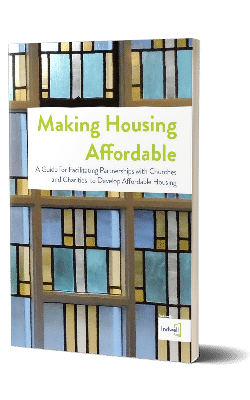
The Passive House design provides considerable benefits; however, it is still a relatively new standard here in North America—and particularly for us. As
such, there are certain things that we’ve discovered along the way that shape how we may do Passive House construction in the future as well as how we
maintain a standard of comfort in our existing Passive House buildings.
- In extreme temperatures in both summer and winter, tenants—new tenants especially—need to be reminded of the building’s efficient design and how to make proper use of it.
- On colder winter days, it is recommended to open window blinds to take advantage of the heat provided by sunlight.
- Conversely, the blinds can be closed if an apartment feels too warm.
- On hot summer days, windows should be kept closed. It can also be helpful to keep blinds closed as an additional measure.
- On spring and fall days where the temperature and relative humidity outside are similar to inside, tenants can open their windows if they wish.
- In apartments built in 2020 and after, tilt and turn windows allow the windows to be tilted (in from top) or turned (hinged in on one side) based on preference and weather conditions. All windows have swing limiters based on building codes.
- The building’s extreme efficiency means small actions will help keep a unit cool in the summer. Tenants will need to be reminded regularly how much heat is produced by devices such as televisions and computers, as well as candles, lamps, etc., and how that affects the overall temperature of the unit.
- Each unit has its own thermostat that can be used to fine-tune the apartment’s temperature. The thermostat may be limited to only function within a specific range, and should remain in the “on” position at all times as all units tie into a weighted average system.
- In Passive House apartments built in 2019 and after, each unit has its own air conditioning unit. This is controlled via the thermostat. At Parkdale Landing in Hamilton, the air conditioning is centrally operated but the thermostat controls a wall radiator that adds additional heat to the apartment if necessary.
- Air is filtered via heat recovery units on the building’s rooftop.
- From our experience, the heat pumps (or wall radiators at Parkdale Landing) are seldom utilized, as the extreme efficiency of the building keeps heat from ambient sources in, and most often no additional heating is needed.
- Because this building has minimized thermal bridging, floors, windows, and exterior walls have a consistent temperature with virtually no cold spots.
- The building’s airtightness means the smoke alarms in units may go off more frequently than standard, air-leaky buildings. Tenants should use their recirculating range hoods to remove smoke/grease from kitchen activities, while the centralized ventilation system removes the stale air.
- Humidity from the apartment is extracted by the bathroom’s exhaust vent, where it brought outside, then filtered, cooled/warmed, and brought back in. It’s important to ensure that these vents are always working.
- It’s very important to use the range hood when cooking.
- Smoking in an apartment or burning candles or incense will trigger the smoke alarm.
- Especially in the summer, the bathroom door should be closed when showering to keep the humidity out of the rest of the apartment. It’s good to keep showers brief and not too hot.
- Using an electric fan can help with circulation as well as making the temperature in the apartment feel cooler.
Most tenants—indeed, most Canadians—have never lived in a high-efficiency or Passive House home, benefiting from its low energy needs, quietness, and air quality. While some aspects may take some getting used to, we trust that the advantages are shared. Our tenants, teams, and buildings are part of helping us collectively address the environmental challenges we all face, while maximizing our living and working experiences.










